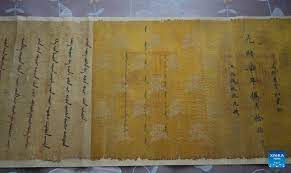Five-Colour Silk Imperial Edict Found In North China’s Hebei Province:

A five-colour silk imperial edict, dating back to Qing Dynasty (1644-1911), was recently found in north China’s Hebei Province.
- Qing Dynasty or Ch’ing Dynasty, or Manchu Dynasty, was the final imperial dynasty in China, lasting from 1644 to 1912.
- It was preceded by the Han-led Ming Dynasty (1368–1644) and followed by the Republic of China era (1912–1949).
- Under the Qing, the empire’s territory grew to treble its size under the preceding Ming dynasty (1368–1644).
- The Qing Dynasty annexed Mongolia, Northeast China, Xinjiang, Tibet, and Taiwan, establishing a territory larger than that of today’s China ,the largest China has ever been.
- In the early 1600s, the Manchu people of northern China began to unite against the Ming Dynasty.
- They formed a somewhat military society and mobilised a large army.
- In 1644, the Manchus crossed the Great Wall and invaded China.
- They soon took control of the Chinese capital city, Beijing, and declared the beginning of a new dynasty called the Qing.
- The first Qing Emperor was a five-year-old boy who became the Shunzhi Emperor.
- The Manchus continued to expand and conquer more of China.
- In 1683, under the Kangxi Emperor, the Qing Empire included all of China.




